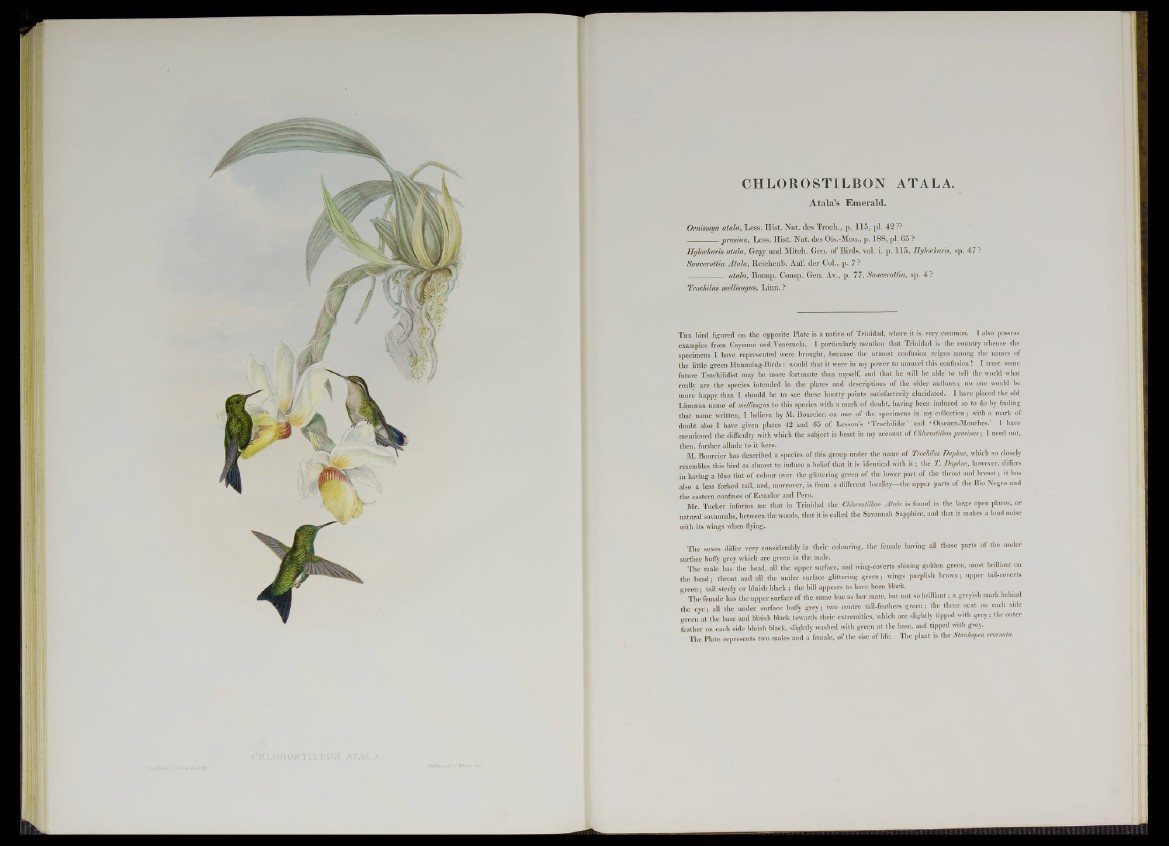
Atala’s Emerald.
Ornwnya atala, Less. Hist. N at. des Troch., p. 115, pi. 42 ??
-------------- prasina, Less. H ist. N a t. des Ois.-Mou., p. 188, pi. 65 ?
Hylocharis atala, Gray and Mitch. Gen. of B irds, vol. i. p . 115, Hylocharis, sp. 47 ?
Saucerottia Ata la , Reichenb. Auf. der Col., p. 7 ?
__________ atala, Bonap. Consp. Gen. Ay., p. 77, Saucerottia, sp. 4 ?
Ti'ochilm mellimgus, Linn. ?
The bird figured on the opposite Plate is a native of Trinidad, where it is very common. I also possess
examples from Cayenne and Venezuela. I particularly mention that Trinidad is the country whence the
specimens I have represented were brought, because the utmost confusion reigns among the names of
the little green Humming-Birds: would that it were in my power to unravel this confusion! I trust some
future Trochilidist may be more fortunate than myself, and that he will be able to tell the world what
really are the species intended in the plates and descriptions of the older authors; no one would be
more happy than I should be to see these knotty points satisfactorily elucidated. I have placed the old
Linnsean name of mettisugus to this species with a mark of doubt, having been induced so to do by finding
that name written, I believe by M. Bourcier, on one of the specimens in my collection; with a mark of
doubt also I have given plates 42 and 65 of Lesson’s ‘ Trochilidai ’ and ‘ Oiseaux-Mouches.’ I have
mentioned the difficulty with which the subject is beset in my account of Cklorostilbon prasinus; I need not,
then, further allude to it here.
M. Bourcier has described a species of this group under the name of Trochilus Daphne, which so closely
resembles this bird as almost to induce a belief that it is identical with i t ; the T Daphne, however, differs
in having a blue tint of colour over the glittering green of the lower part of the throat and breast; it has
also a less forked tail, and, moreover, is from a different locality—the upper parts of the Rio Negro and
the eastern confines of Ecuador and Peru.
Mr. Tucker informs me that in Trinidad the Chlorostilbon Atala is found in the large open places, or
natural savannahs, between the woods, that it is called the Savannah Sapphire, and that it makes a loud noise
with its wings when-flying.
The sexes differ very considerably in their colouring, the female having all those parts of the under
surface huffy grey which are green in the male.
The male has the head, all the upper surface, and wing-coverts shining golden green, most brilliant on
the head; throat and all the under surface glittering green; wings purplish brown; upper tail-coverts
green ; tail steely or bluish black ; the bill appears to have been black.
The female has the upper surface of the same hue as her mate, but not so brilliant; a greyish mark behind
the eye; all the under surface huffy grey; two centre tail-feathers green; the three next on each side
green at the base and bluish black towards their extremities, which are slightly tipped with grey; the outer
feather on each side bluish black, slightly washed with green at the base, and tipped with grey.
The Plate represents two males and a female, of the sire of life. The plant is the Stauhopea ecormla.